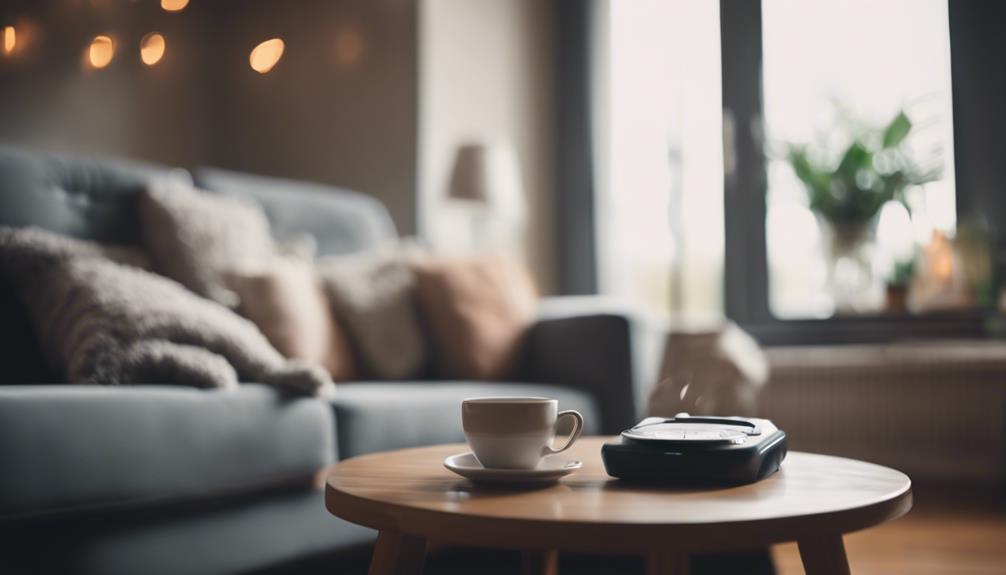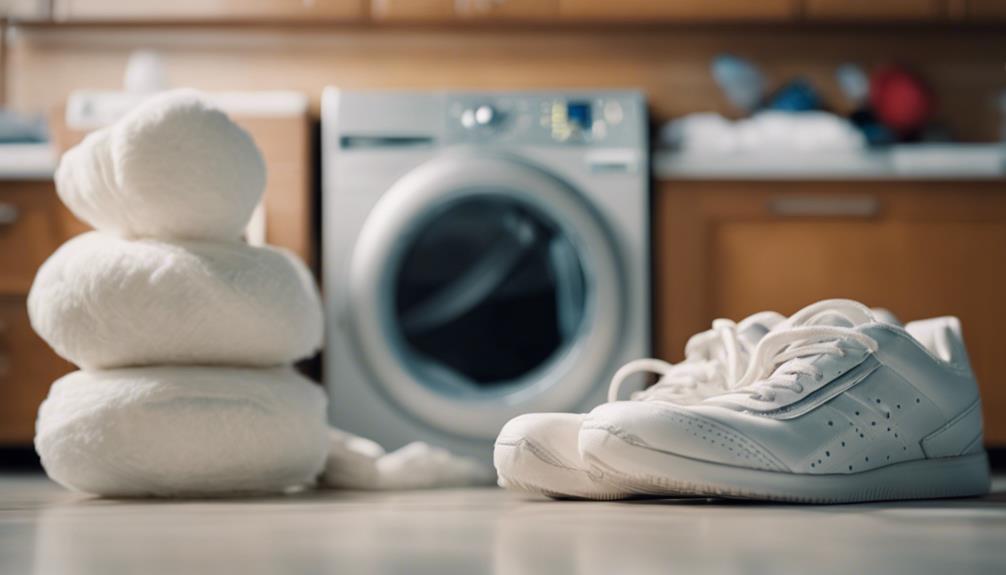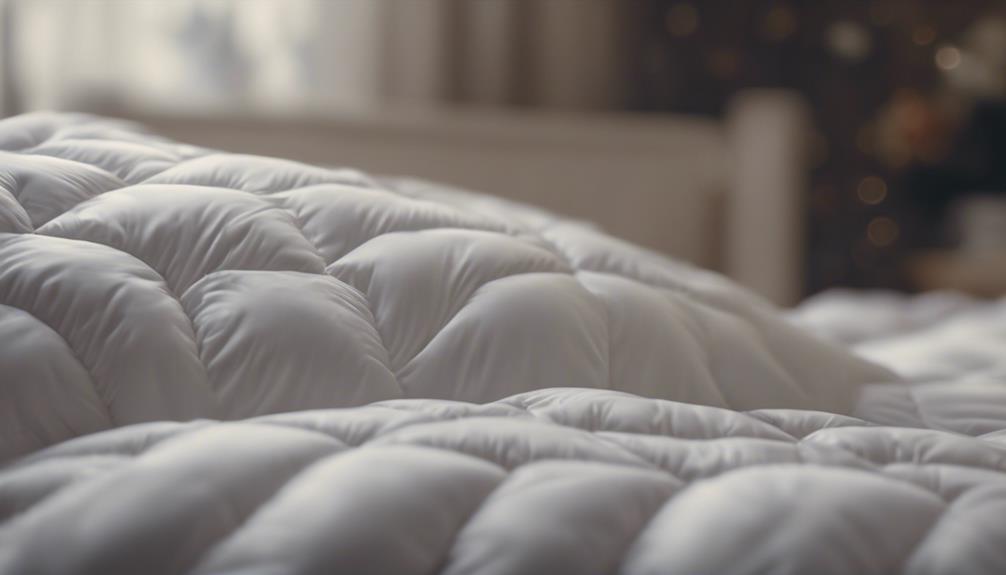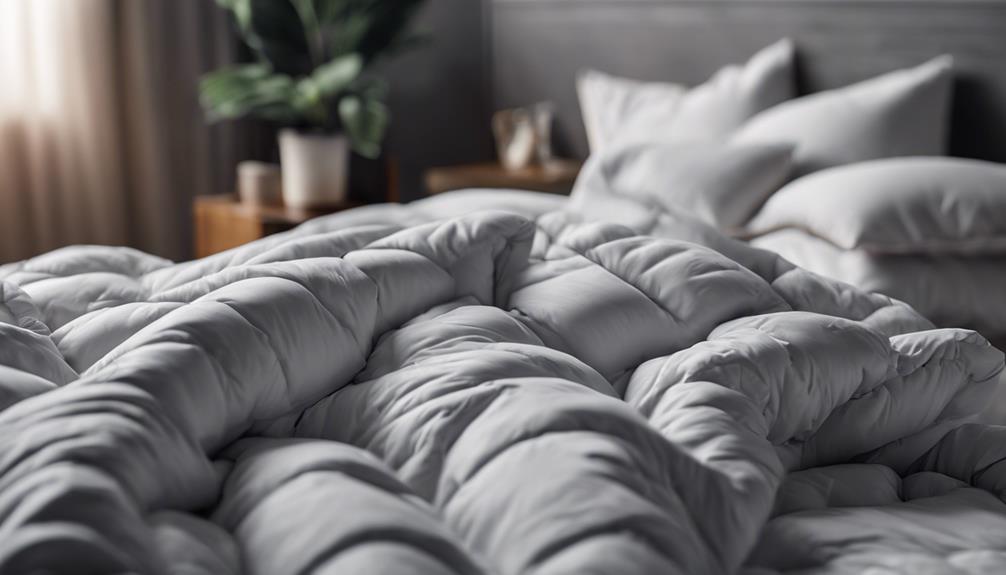Using a down comforter in the summer can provide excellent comfort and breathability on warmer nights. Down comforters are celebrated for their airflow and moisture-wicking capabilities. They are lightweight and adaptable for all seasons. When selecting one, opt for a lower fill power and thin layers to enhance breathability. Look for materials and designs specifically labeled for warm weather use. If you are interested in learning about the advantages and maintenance tips for down comforters in hot weather, using one can help you understand how to maximize comfort during the summer. Additional details on keeping cool with a down comforter can be found here.
Key Takeaways
- Down comforters are breathable and moisture-wicking.
- Opt for lightweight options with lower fill power.
- Look for summer-specific designs for warm weather.
- Consider thin layers and materials for better airflow.
- Explore alternatives like down blankets or bamboo bedding.
Pros and Cons of Using Down Comforters in Summer
Using a down comforter in the summer offers a balance of breathability and comfort, ideal for warm nights. Down comforters are known for being breathable, allowing air to circulate and prevent overheating. The moisture-wicking properties of down help absorb sweat, keeping you dry and comfortable throughout the night. The high loft of down comforters is beneficial for summer use as it helps regulate body temperature, ensuring you stay cool when it's hot outside.
These lightweight down comforters are specifically designed to provide the right amount of warmth without feeling heavy or stifling during the summer months. Their versatility allows them to be used in all seasons, making them a practical choice for those looking for a single bedding option for the whole year. Additionally, down comforters without chemical additives are excellent for temperature regulation, ensuring a restful night's sleep even on the warmest of nights.
Choosing the Right Lightweight Down Comforter

When selecting a lightweight down comforter for summer, consider the summer down comforter options available.
Look for comforters with the right weight and insulation levels for warm nights.
Pay attention to the material and breathability of the comforter to guarantee a comfortable sleep experience.
Summer Down Comforter Options
During the warmer months, selecting a lightweight down comforter tailored for summer can enhance your sleep experience. Summer down comforters are designed to be breathable, making them ideal for hot nights. Look for options with lower fill power, thinner layers, and excellent breathability. These features help prevent overheating while still providing comfort.
A lightweight down comforter with a lower fill weight is perfect for ensuring a cool and restful sleep during summer. When choosing a down comforter for the summer, opt for those specifically labeled or designed for warm weather use to guarantee the best sleeping conditions.
Weight and Insulation
As we consider lightweight down comforters tailored for summer use, the focus shifts to the significance of weight and insulation in selecting the right option for a cooler sleep experience. Lightweight down comforters are designed to offer less insulation, making them ideal for warmer nights.
When choosing a lightweight down comforter for summer, pay attention to the fill power, which determines its fluffiness and ability to provide comfort without overheating. Opt for a down comforter with a lower fill power, such as 600 or below, to prevent feeling too hot. These comforters are breathable, allowing for air circulation and moisture-wicking properties. Look for a lightweight down comforter with a thin outer fabric to enhance breathability and avoid trapping excess heat during the summer months.
- Choose a down comforter with a lower fill power for summer nights.
- Lightweight down comforters offer breathability for a comfortable sleep experience.
- Opt for a thin outer fabric to enhance breathability.
- Pay attention to the fill power for comfort without overheating.
- Lightweight down comforters provide less insulation for warmer nights.
Material and Breathability
Selecting the appropriate material and ensuring breathability are key factors when choosing a lightweight down comforter for summer use. Lightweight down comforters are ideal for hot weather due to their breathable and moisture-wicking properties.
The breathability of down comforters allows for temperature regulation and moisture control, ensuring a comfortable sleep without feeling too warm. Down comforters with high loft provide insulation while still feeling lightweight.
Opting for chemical-free down comforters can further enhance temperature regulation and breathability during summer nights. Choosing a down comforter with breathable construction helps prevent overheating, making it a suitable choice for those looking for a comfortable and cool sleep experience in the summer.
Benefits of Down Comforters in Warm Weather

In warm weather, down comforters offer exceptional benefits for a comfortable and restful night's sleep. Here are some reasons why they're great for warm nights:
- Breathable: Down comforters allow air to circulate, preventing overheating during summer use.
- Lightweight: They're easy to move and adjust, providing comfort without feeling heavy.
- Moisture-wicking: The down clusters in the comforter pull moisture away from the body, keeping you dry and comfortable.
- Temperature regulation: Down comforters help regulate body temperature, ensuring a peaceful sleep even in warm weather.
- Summer use: Designed to be breathable and lightweight, down comforters are ideal for use during the summer months.
These benefits make down comforters a versatile bedding option suitable for all seasons, ensuring a good night's sleep regardless of the weather outside.
Tips for Keeping Cool With a Down Comforter

When trying to stay cool with a down comforter in the summer, opt for a lightweight option that offers good breathability. Thinner down comforters or those specifically designed for summer use can help regulate temperature.
Consider pairing your down comforter with cooling fabric choices like silk sheets or bamboo bedding for added comfort.
Summer Down Comforter Benefits
During the hot summer months, enjoying a restful night's sleep with a down comforter is made possible by its moisture-wicking properties, high loft, and breathability.
- Down comforters aren't too hot for summer nights.
- They've moisture-wicking capabilities to keep you dry.
- The breathable construction allows for airflow, preventing overheating.
- These comforters regulate temperature, ensuring a peaceful sleep even in warm weather.
- Opt for lightweight down comforters for a comfortable and cool rest.
Lightweight Down Options
Considering the scorching summer heat, we seek comfort with lightweight down options that promise a cool and restful night's sleep. Lightweight down comforters are designed to be breathable and moisture-wicking, making them ideal for summer use.
Opt for a down comforter with lower fill power for a lighter weight option in hot weather. Look for down comforters made with natural materials like cotton or bamboo, as they enhance breathability and comfort. These natural materials help regulate body temperature, ensuring a comfortable sleep even on warmer nights.
Choosing a lightweight down comforter can provide the perfect balance of warmth and breathability for a rejuvenating summer slumber.
Cooling Fabric Choices
To enhance comfort during hot summer nights with a down comforter, selecting cooling fabric choices is essential. Here are some tips for keeping cool with a down comforter in warmer weather:
- Silk sheets: Feel cooler against the skin in tropical climates when paired with a down comforter in summer.
- Bamboo: Utilize bamboo or tatami mats to help stay cool when using a down comforter during warmer weather.
- Thinner down blanket: Opt for a thinner down blanket to provide comfort without overheating in summer.
- Fan direction: Direct a fan towards the stomach or feet to help regulate body temperature while using a down comforter in hot weather.
- Avoid certain mattresses: Steer clear of latex or memory foam mattresses as they may hinder proper airflow when using a down comforter in summer.
How to Maintain Comfort With Down in Summer
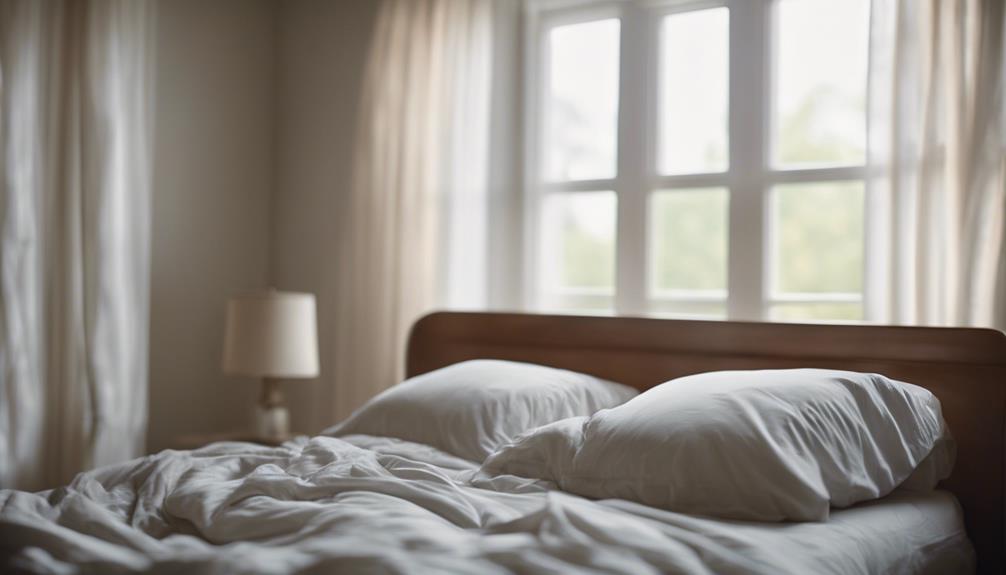
To maintain a cool and comfortable feel with a down comforter in the summer, prioritize selecting breathable and lightweight options. Down comforters excel in temperature regulation and moisture-wicking, making them ideal for summer nights. Their high loft and breathability guarantee a peaceful night's sleep without feeling too hot.
Opting for a lightweight down comforter, especially those without chemical dyes, enhances temperature regulation further. These features allow down comforters to be versatile for all seasons, including summer. By choosing a breathable and lightweight down comforter, you can experience a comfortable sleep environment even in warmer weather.
The moisture-wicking properties of down help prevent you from feeling sweaty or sticky during the night, contributing to a revitalizing and restful sleep experience in the summer months. Enjoy the benefits of down comforters while staying cool and comfortable throughout the summer nights.
Alternatives to Down Comforters for Summer
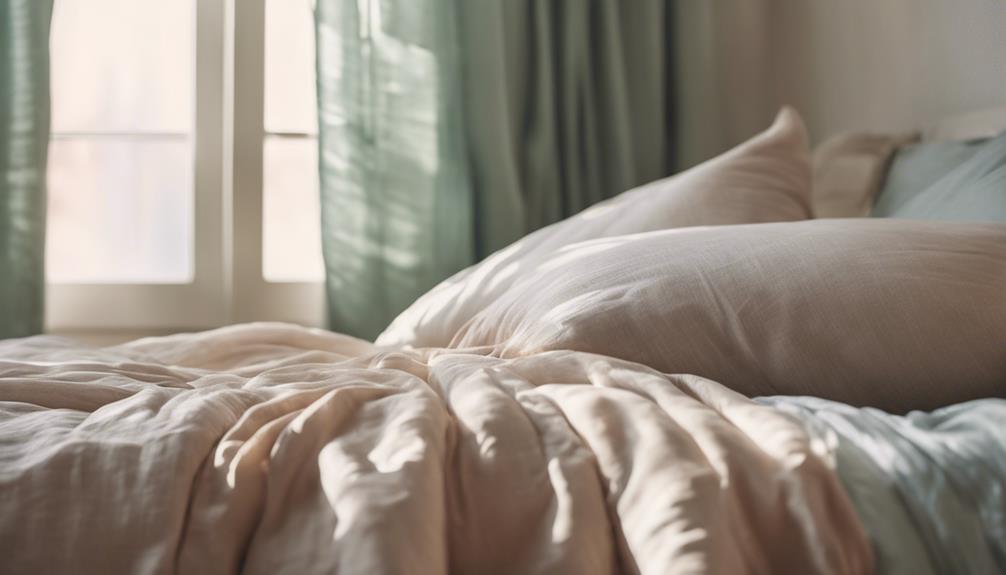
During warmer months, exploring alternatives to down comforters can enhance sleeping comfort without compromising on quality or style. When looking for options to stay cool in the summer, consider the following:
- Light-weight down blankets: Opt for a thinner layer of warmth compared to traditional down comforters for a more suitable option in warm weather.
- Silk sheets: These luxurious sheets can help regulate body temperature and provide a cool sleeping surface during hot nights.
- Bamboo bedding: Bamboo is a breathable material that can wick away moisture, keeping you comfortable and cool throughout the night.
- Proper airflow: Ensuring good air circulation in your bedroom can help prevent overheating and maintain a comfortable sleep environment.
- Cotton bedding: Cotton is a natural, breathable fabric that's ideal for summer bedding due to its ability to keep you cool and comfortable.
Exploring these alternatives can help you find the perfect bedding option to guarantee a restful night's sleep during the summer months.
Down Comforter Care in Hot Weather
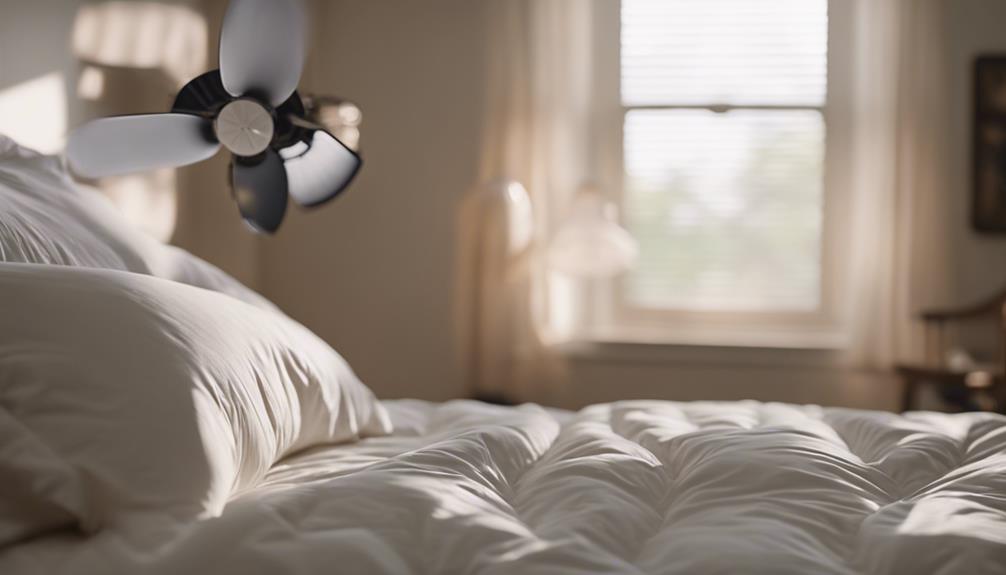
Exploring how to maintain down comforters during hot weather involves practicing proper care measures to maximize their comfort and longevity. Down comforters can still be used in the summer due to their lightweight design, breathability, and moisture-wicking properties.
To care for them in hot weather, it's crucial to regularly air them out to prevent moisture buildup. Washing them annually and using a duvet cover for protection can also help preserve their quality. Opting for a lighter weight down comforter or choosing one with a lower fill power can make it more suitable for summer use, preventing overheating while still providing comfort and insulation.
In particularly hot summer months, using a down blanket or a Matelassé coverlet can be a cooler alternative to a traditional down comforter. By following these proper care tips, you can guarantee that your down comforter remains in good condition and continues to provide comfort during the summer.
Maximizing Comfort With Down in Summer

In the summer months, maximizing comfort with a down comforter involves choosing a lighter-weight option to prevent overheating while still enjoying the benefits of down's breathability. When selecting a down comforter for summer use, consider the following:
- Breathability: Look for a down comforter that offers excellent breathability to guarantee airflow and prevent you from feeling too hot.
- Moisture-wicking: Opt for a comforter with moisture-wicking properties to help keep you dry and comfortable during warm nights.
- Lightweight: Choose a lightweight down comforter as it provides the right amount of insulation without feeling heavy or cumbersome.
- Chemical-free: Prioritize down comforters that are free from chemical dyes or additives to avoid any potential skin irritation and promote better temperature regulation.
- Tropical climates: Lightweight down comforters are particularly suitable for tropical climates, offering the perfect balance of breathability and comfort for hot and humid nights.
Frequently Asked Questions
Do Down Comforters Get Hot?
When choosing a down comforter, it's crucial to take into account the fill power. Lower fill power options are more effective in preventing overheating.
For a cooler sleep experience in the summer, lightweight down comforters or alternative bedding options may be more comfortable.
It's all about striking the right balance between warmth and breathability.
Can Comforters Be Used in Summer?
Yes, down comforters can be used in summer. Their moisture-wicking properties and breathability make them ideal for warm nights. They regulate body temperature and provide a cozy sleep experience in any season.
Opt for a lightweight down comforter without chemical dyes for best temperature control during summer. Choosing a breathable option guarantees comfort without overheating when the temperatures rise.
Embrace the benefits of a down comforter for a peaceful night's sleep year-round.
Is Down Too Warm for Summer?
Yes, down comforters can be used in the summer. Their moisture-wicking properties, high loft, and breathability make them suitable for warmer weather.
Down comforters regulate body temperature and wick away moisture, ensuring a comfortable night's sleep even in the summer. Lightweight options are breathable and won't cause overheating.
With good temperature regulation and durability, down comforters are versatile enough to be used in any season, including summer.
When Should You Throw Out a Down Comforter?
When should you throw out a down comforter?
It's time to replace it when it loses fluffiness and warmth, affecting insulation.
An odor that persists after cleaning or signs of wear like rips and tears are red flags.
Accumulated dust mites, allergens, and mold can pose health risks.
If it no longer provides the comfort and warmth needed, investing in a new one is essential for better sleep quality.
Is a European Down Comforter Suitable for Summer Use?
A European down comforter, by definition, is a lightweight and breathable bedding option. These comforters are suitable for summer use as they provide insulation without overheating. The natural down filling allows for air circulation, making it an ideal choice for warm weather comfort.
Conclusion
So, can you use a down comforter in the summer? Absolutely!
Just make sure to choose a lightweight option, keep your room cool, and follow some simple tips for staying comfortable.
And hey, if all else fails, there's always the option of kicking off the covers and embracing the summer heat.
Stay cool, my friends!

